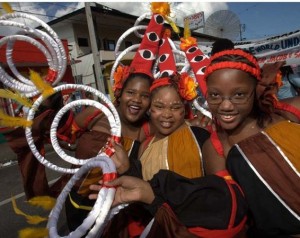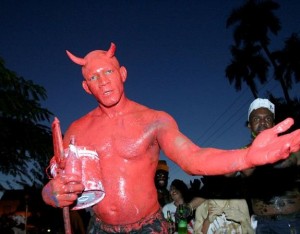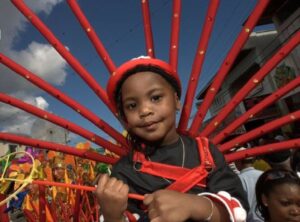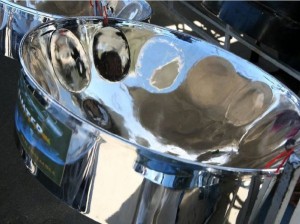
Just as New Orleans celebrates its Mardi Gras on the day before Ash Wednesday, the streets in down town Port of Spain, Trinidad erupt into one of the largest street masquerade parties in the Caribbean. It takes place, not in one, but two whole days–known as Carnival Monday and Carnival Tuesday–before Ash Wednesday. It sees people frolic in the streets dressed in sequins, feathers and bright sunshine colored costumes. The dancing doesn’t stop as they move and gyrate down the streets to the sound of live DJs and bands that blast calypso and soca music with a bass that sets the pace.
The history of Trinidad Carnival goes all the way back to1838, following the emancipation of African slaves by the then-ruling British government. The slaves were only then allowed to partake in the pre-Lenten festivities originally upheld by the British.

The African slaves introduced the art of Cannes Brulees, which in essence is comprised of stick fighting; characters such as Moko Jumbie, which are masqueraders on stilts; the familiar black and white painted faces of Minstrels; two distinct devil characters known as “Jab Jab,” which are pretty devils, and “Jab Molassie,” which are scary devils; red Indians complete with featured headdress; a Midnight Robber dressed in a black cape with a huge brimmed hat; and, of course, fancy sailors who dust the air with sweet-smelling talcum powder. These make up what is known as traditional mas and are still represented in the carnival procession today.
Nowadays, Carnival is celebrated on a grand scale with bands of masqueraders making up a strong jubilant crowd of tens of thousands of people. The “bands” as they are locally called, belong to masquerade companies that design and create carnival costumes to sell to the public. Some of the most popular bands are “Young Harts,” “Poison” and “Spice”, which are geared towards the under 25 age group and produce sizzling costumes that resemble those worn by Las Vegas cabaret showgirls.
The immense scale of this street celebration involves so much preparation that there is a specific National Carnival Commission (N.C.C.) to oversee the business aspects of staging this huge celebration.
In fact, in 1964 the Caribbean community in London began their very own annual August celebration known as the Notting Hill Carnival, based on the vibrant sights and sound of Trinidad Carnival. Since then, it has flourished and features a lot of the Caribbean artists who grace the stages of carnival held across the Caribbean.

Carnival officially kicks off in October with the band launching. This entails each band showcasing their costumes for the upcoming Carnival presentation. These are done in elaborate catwalk programmes with models wearing the costumes for the different section among the public, invited guests and the media. For those who are unable to make it to the launch, most of the carnival bands have an Internet presence where virtual visitors can pick, choose, state size measurements and register for a costume without having to board a plane or rely on someone else. Each costume is then created on an individual basis and prepared for collection in the weeks prior to the actual date of Carnival.
The music of Carnival generally begins as the carols, hymns of Christmas come to a close, and the New Year begins. Radio stations begin to specifically play Carnival songs on the airwaves with an array of calypso, chutney and soca songs that spur on the text voting of the various Monarch competitions. There are two divisions, the Chutney Soca Monarch, which relates to the Indo-Caribbean fusion of calypso songs, and the International Soca Monarch.
At least one month prior to the date of Carnival there are various fetes and parties that take place at venues across the country, many of which have all-inclusive food and drink. Young and old take part in these celebrations, which tend to feature live performances of local artists.
The annual steel pan competition also gets under way at the four cardinal points of Trinidad and Tobago. It is known as “Panorama” and features competition heats between four different-sized bands such as single, small, medium and large pan, where points are awarded for tone, rhythm, musical arrangement and overall performance. The large bands are truly big, with up to 100 players whose energy and enthusiasm will excite the most docile traveler. The competition comes to an end at the grand stand, Queen’s Park Savannah in the capital of Port of Spain, where the winner in each band category is awarded a title and prize money.

Another aspect of Carnival that takes place in the buildup to the date is the comedic stylings of the “Talk Tents.” It is an integral part of the celebrations where fun is poked at politics, celebrity and local stories.
The big show before Carnival Monday is called “Dimanche Gras” and is held on the Sunday night at the Grand Stage, Queens Park Savannah. The King and Queen of Carnival masquerade across the stage and there is musical entertainment from calypsonians who sing lyrics about sociopolitical commentaries.
Carnival Monday begins in the wee hours of the morning just as dawn breaks with a type of people’s parade where mud, blue devils and more sociopolitical commentaries are made into visual statements.
All of these events occur prior to the colorful parade of Carnival Monday and Carnival Tuesday, which is really the culmination of six months of work, with the streets becoming the venue for a massive street party. Here people of all ages, race and social class come together.
Many visitors arrive the week before Carnival to fully immerse themselves in the fetes, parties, monarch competitions, steel bands competition and the euphoria that is the internationally acclaimed event known as Trinidad Carnival.

